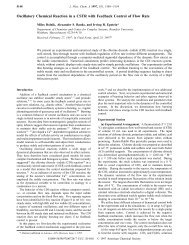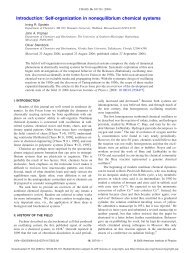Nonlinear Chemical Dynamics: Oscillations, Patterns, and Chaos
Nonlinear Chemical Dynamics: Oscillations, Patterns, and Chaos
Nonlinear Chemical Dynamics: Oscillations, Patterns, and Chaos
Create successful ePaper yourself
Turn your PDF publications into a flip-book with our unique Google optimized e-Paper software.
<strong>Nonlinear</strong> <strong>Chemical</strong> <strong>Dynamics</strong> J. Phys. Chem., Vol. 100, No. 31, 1996 13141<br />
Figure 10. Propagating waves on BZ membrane with cellular<br />
inhomogeneities. The catalyst patterns appear as the background;<br />
unloaded <strong>and</strong> loaded regions are white <strong>and</strong> red, respectively. The<br />
triangular patterns give rise to hexagonal wave propagation. Image area<br />
) 14.5 cm 2 . The positions of the waves, obtained by subtraction of<br />
successive video frames, were superimposed on the background image,<br />
with blue assigned to the wave front <strong>and</strong> violet assigned to the wave<br />
back. Reprinted with permission from ref 160. Copyright 1995<br />
American Association for the Advancement of Science.<br />
created, typically by either physically or chemically inducing<br />
wave breaks. 11,151 Spirals may also appear with special initial<br />
conditions such as cross-field stimulation 157 or wave initiation<br />
in the vulnerable refractory region of a preceding wave. 158<br />
Studies of the BZ reaction with the catalyst loaded on ionexchange<br />
beads 159 or printed on membranes in specific patterns<br />
160 have shown that interacting regions with different<br />
excitabilities give rise to the spontaneous appearance of spiral<br />
waves. This may occur at spontaneous wave initiations in the<br />
vulnerable refractory region of another wave, 160 as recently<br />
shown in studies of BZ waves on catalyst-loaded Nafion<br />
membranes. 161 Patterned excitable media also give rise to global<br />
anisotropy in wave propagation that reflects the local cellular<br />
geometry, such as the hexagonal waves on the checkerboard<br />
grid of triangles shown in Figure 10. Detailed studies of the<br />
effects of local inhomogeneities on global wave behavior have<br />
also been carried out with the Pt-CO system by Graham et<br />
al., 162,163 where complex boundaries <strong>and</strong> patterns were created<br />
by photolithography.<br />
The transverse coupling of chemical waves has been studied<br />
in several different configurations. Waves on the surfaces of a<br />
ferroin-loaded Nafion membrane immersed in a BZ solution<br />
couple via transport of the autocatalyst through the membrane. 164<br />
This coupling gives rise to entrainment of the wave behavior<br />
on both membrane surfaces as well as spontaneous spiral<br />
sources. Modeling studies of transverse coupling of chemical<br />
waves have demonstrated that exceedingly complex bifurcation<br />
sequences arise, even in one-dimensional configurations. 165,166<br />
Communication between chemical waves has also been studied<br />
in layers of chromatographic medium saturated with BZ<br />
solution. 167,168 In this configuration, two separate wave patterns<br />
appear, one on the top <strong>and</strong> the other on the bottom of the layer.<br />
Modeling studies have shown that a nonmonotonic excitability<br />
profile separates the top <strong>and</strong> bottom patterns, which interact to<br />
form intricate crossing wave patterns. 169<br />
Figure 11. Subtraction images showing chemical waves at 10 s<br />
intervals traveling inside capillary tubes of 50 µm radius. Input of waves<br />
in both tubes with output in gap demonstrates AND gate behavior.<br />
Field of view: 0.38 mm × 2.58 mm in top four panels <strong>and</strong> 0.64 mm<br />
× 2.58 mm in bottom panel. The gap between the tube exits is 180<br />
µm. Reprinted with permission from ref 172. Copyright American<br />
Institute of Physics.<br />
The propagation of chemical waves through precision-bore<br />
capillary tubes provides a means to directly measure the critical<br />
nucleation size in excitable media. 170 A wave enters <strong>and</strong> travels<br />
through a capillary tube immersed in a BZ solution <strong>and</strong> forms<br />
a hemisphere of excited solution at the exit. When the tube<br />
diameter is greater than a critical value, the excitation serves to<br />
initiate a wave; otherwise, the excitation collapses <strong>and</strong> no wave<br />
is initiated. The critical nucleation size from such experiments<br />
is in good agreement with theoretical predictions 152 <strong>and</strong> indirect<br />
measurements based on the wave velocity dependence on front<br />
curvature. 171 Combinations of two or more capillary tubes can<br />
be configured into logic gates, based on input <strong>and</strong> output signals<br />
in the form of chemical waves. 172 An example of an AND gate<br />
is shown in Figure 11, which is comprised of two tubes with<br />
radii slightly smaller than that corresponding to the critical<br />
nucleation radius of the chemical medium. The tubes are<br />
positioned such that two waves exiting simultaneously give rise<br />
to wave initiation, while a single wave in either tube collapses<br />
at the exit. Many other logic gates are possible, <strong>and</strong> a suitable<br />
collection could be assembled into chemical wave circuitry for<br />
computational tasks. The propagation of a single wave through<br />
a maze can form the basis of an algorithm for determining<br />
minimum-length paths. 173 Optimal pathways through complex<br />
labyrinths prepared with a membrane-BZ system have been<br />
determined from time-lapse video information on chemical wave<br />
position. 174 Propagating waves in excitable media provide an<br />
interesting <strong>and</strong> potentially useful alternative to traditional<br />
methods for determining optimal paths <strong>and</strong> point to possible<br />
mechanisms for self-optimization in biological systems. Ross<br />
<strong>and</strong> co-workers 73,175 have carried out extensive theoretical<br />
studies of “chemical computers” based on reactor systems<br />
coupled by mass flow.<br />
The oxidation of CO on single-crystal Pt has proven to be<br />
an extraordinarily rich system for studies of spatiotemporal<br />
behavior. 176 The surface-catalyzed oxidation takes place with<br />
a reconstruction of the Pt surface, <strong>and</strong> the associated propagating<br />
waves give rise to target <strong>and</strong> spiral patterns. 177 The wave<br />
patterns have been visualized with remarkable clarity using





